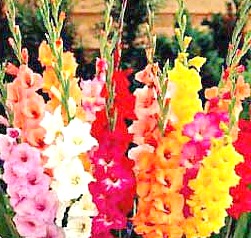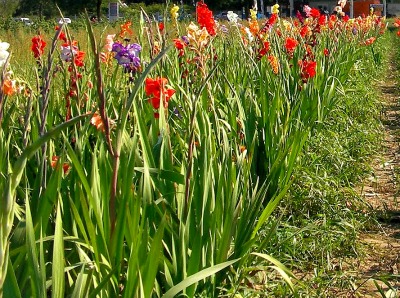 Gladiolus is a genus of perennial bulbous flowering plants in the iris family (Iridaceae), the plural form of which can be Gladiole, Gladioluses or Gladioli. Gladiolus is also known as the Sword Lily, due to its sword shaped leaves, or Corn Lily. These attractive, perennial herbs are semi-hardy in temperate climates. They grow from rounded, symmetrical corms, that are enveloped in several layers of brownish, fibrous tunics. Gladiolus last seven to 10 days and are available in a wide variety of colors including white, green, cream, yellow, buff, orange, salmon, pink, red, lavender, purple, blue and terra cotta. The cut plant will enjoy the vase life for minimum 6 days. Like most flowers, gladiolus carries a distinct elegance and very much in demand during the month of November.
Gladiolus is a genus of perennial bulbous flowering plants in the iris family (Iridaceae), the plural form of which can be Gladiole, Gladioluses or Gladioli. Gladiolus is also known as the Sword Lily, due to its sword shaped leaves, or Corn Lily. These attractive, perennial herbs are semi-hardy in temperate climates. They grow from rounded, symmetrical corms, that are enveloped in several layers of brownish, fibrous tunics. Gladiolus last seven to 10 days and are available in a wide variety of colors including white, green, cream, yellow, buff, orange, salmon, pink, red, lavender, purple, blue and terra cotta. The cut plant will enjoy the vase life for minimum 6 days. Like most flowers, gladiolus carries a distinct elegance and very much in demand during the month of November.
How to grow Gladiolus Flower
Gladiolus Varieties
Because of its florets’ many colors and forms, gladiolus cultivars are classified (using a three-digit number) according to floret size (first digit), basic color (second digit), and depth of color (third digit). The size of the floret can be determined by measuring the diameter of the lowest floret without flattening its petals.
The basic color range represented by the second digit ( from 0 to 8 ) corresponds to a progression of colors from yellow to green, orange, red, purple and violet. Cultivars with smoky hues are assigned a number of 9, depending upon the base color. White is given a 0 value.
Planting Materials
Gladiolus may be propagated by seeds, corms, cormels and by micropropagation. Choose only those disease-free corms and cormels. To prevent diseases from developing, treat cormels with hot water (53 to 55°C) for 30 minutes. Chemicals like captan, thiram or thiobendezole can be added to the water. Before treating the cormels, soak them in a warm water (32°C) to soften the husk and remove all those that float. Put clean cormels in sacks or net bags then, immerse them in hot water with the chemical with 30 minutes. After the treatment, immerse the sacks containing cormels in a container with running water for 10 minutes. After air-drying, store cormels under low temperature (20 to 5o°C) for at least three months to break their dormancy. When the root buds swell, they are no longer dormant. To get uniform germination, soak cormels in water two days before planting them.
Plant cormels at the rate of about 130 to 150 cormels per meter row with about 60 to 70 cm-distance between rows. When cormels are big, a lesser number is used per meter row.
To prevent corms from getting diseases, treat them with the same chemicals used for cormels. But this time, reduce the water temperature to 40°C and the soaking time to 15 minutes. Plant them at densities of about 50 to 80 corms per meter row with 60 to 70 cm distance between rows. Two to three weeks before corm harvest, stop irrigating to enhance faster curing and cleaning of corms.
During its growth, a corm is being replaced by a new one which grows above the old corm. When you plant a big corm. you get two to four or even more new but smaller corms. The remains of the old corm hold the new ones together until it is removed.
When you have only few corms of a certain variety, cut one corm into two size. To locate the eyes, peel back the husk or the outer covering of the corm. Dust the cut surfaces with sulfur or fungicide . Dry the pieces for a day or two and plant them just like ordinary bulbs. Seeds, on the other hand, may be seeded directly in the field or transplanted. Plant the seeds 1.4 to 1.2 inch-deep in rows and 1 1/2 to 3 inches apart.
Adaptation
Gladiolus grows best in fertile soil with 7.0 to 7.5 pH. Areas not planted to it for at least three years are preferred because the incidence of soil-borne diseases will be less.
If you are going to use the same area, treat the soil (soil fumigation) with methylchloropicrin at the rate of about 400 kg per hectare.
Cultural Practices
Use large corms for cut flower production. You can use a planting density of 13 to 17 corms per meter row distanced at about 20 cm apart. For sandy soil. Use wider spacing. Normally, a ten-centimeter planting depth is used. But it also varies depending on soil type and cultivars. Deeper planting applies to lighter soil and taller cultivars. So planting depth should be adequate to support the plant and prevent it from being uprooted by strong winds. To avoid this, plant corms at a shallow depth and then hill up as they grow taller.
Provide enough water during the plant’s growth up to flowering but avoid excess moisture. After planting up to the appearance of the leaves, and just before spike emergence (Between the four-to-six-leaf stages), the plant is very sensitive to moisture stress. Lack of soil moisture reduces flowering and temporary wilting and plants cause crooked spikes.
Gladiolus, known for its high light requirement, suffers also under very high light intensity. Under this condition, the length of the spikes and the quality of the florets decreases.
The plant can also tolerate high temperature (up to 50°C) provided air humidity and soil moisture at an optimum.
Remember that the nitrogen requirement of the plant during its growth is larger than its nitrogen requirement after flowering. Also, insufficient nitrogen may result in delayed flowering and less florets per spike.
Sandy soil and areas with frequent rainfall require more fertilizer. Provide gladiolus grown in the sandy soil with about 90 to 135 kg of nitrogen per hectare (ha), 90 to 180 kg of phosphorus per ha, and 110 to 180 kg of potassium per ha. The fertilizer mixture may be applied four times: before planting, during 3 to 3 leaf stage (side-dressing), when inflorescence emerges from the leaves (side-dressing) and about two weeks after flowering (side-dressing).
Pest and Diseases
Some pest that attack gladiolus are aphids, trips, mites, bugs earworm and borers. Diseases afflicting gladiolus are scab, leaf and flower spots and Fusarium disease. For proper chemical control, refer to local insecticide and pesticide dealers.

Harvesting
If you are harvesting flowers for distant markets, for export and for long-term storage, cut the flower spikes when the flower florets show color. For the domestic market, begin harvesting when the lower 2 to 3 are fully open. when harvesting, cut the spikes with a sharp knife; retains as many leaves as possible and avoiding wrenching the corm from the ground. Cut the spikes by slipping a knife down between the leaf blades with the cutting edge upward and then draw the blade through the stem, holding the tip of the spikes with the other hand.
Do you cutting early in the morning or the late in the afternoon. Flowers cut during these periods last longer.
When the harvesting corms, lift them from the ground when the top of the plants has turned yellow or when the cormels have turned mauve in color. That would be about 6 to 8 weeks after the flowers have been cut. Harvest the corms during sunny days and dig them manually or mechanically.
Post-harvest Handling and Storage
After cutting, carry spikes carefully with all the florets facing upward. Place the bunched spikes in deep water or preservative and hold them upright because the stem will bend upward if placed in a horizontal position. Spikes held upright at 5°C in low humidity for two days or held out of water for several hours at high temperatures do not bend when later placed in a horizontal position.
Store the cut flowers at 5°C for 10 to 15 days. Addition of preservatives in holding solution before, during and after storage can considerably extend vase life.
Spikes are sorted into different grades based on overall quality, spike length and floret number. After grading, they are bunched and kept in a cool place preferably at 4 to 5°C until packed.
Regarding corms, place them in slatted or screened shallow trays (about 10 cm deep) after they are dug. store under airy shade for cutting at 27o to 32°C with a relative humidity between 40 to 50 per cent until corms clean easily. To avoid the build-up of heat, place only four layers of corm in each tray. Dry the corms beginning at 32°C for 24 hours then, reduce it to 27oC until they have dried completely. Good drying encourages the hardening of the husk and drying of the old corm so that it will separate from the new daughter corm. Clean the corms after curing. Remove loose outer scales.
Corms are stored to extend the span of their viability and shorten the length of their dormancy because at the time of digging, the corm is vegetative and dormant. As the size of the corm increases, dormancy decreases; cormels are also more dormant than corm of flowering sized.
For recently harvesting corms, high temperature (35°C) prolong their dormancy period. Corms of some cultivars remain dormant for 12 to 18 months at 27°C.
If you store corms for a short period (4 to 6 months), a temperature of 4°C should be maintained. Corms in dry storage do not sprout below 4°C.
Breaking the Dormancy of Corms
To break dormancy fast, store corms at 4 to 5°C for three to six weeks. For corms and cormels with very long dormancy period, store them for 3 to 4 months to break their dormancy. Cold-stored corms may be transferred to 27 to 32°C for two weeks before planting to stimulate early germination and flowering.
Another of breaking the dormancy is through the use of chemicals. Corms and cormels after at least one week of cold storage are sealed in one-liter container with 4-mL of 40 per cent ethylene and chlorydrin solution and then held at room temperature for three to four days.
Another chemical procedure for breaking dormancy is to soak the corms and cormels in a 3 per cent solution of ethylene and chlorydrin for 3 to 4 minutes and then seal them in a tight glass container for 24 hours at 23°C.
Corms and cormels that are planted immediately after treatment will sprout within 3 to 4 weeks. Storing corms treated with 500 ppm (parts per million) gibberellic acid for a day can also hasten germination.
Evaluating Cultivars
Here are the criteria used in selecting and evaluating good cultivars for the commercial production of cut flowers. Look for gladiolus with florets of clear color, a diameter of at least 11.4 cm wide for the large cultivars, and good texture and placement.
Size and color of Gladiolus as designated by the North American Gladiolus Council.
For more information, contact:
Dept. of Science and Technology
Rm. 303 DOST Bldg., DOST Complex,
Gen. Santos Ave., Bicutan, Taguig City 1631
Tel. No.: (632) 8837-20-71 to 82
Fax: (632) 8837-8937
Visit Website (This link will open on a new window)
Sources: region10.dost.gov.ph, en.wikipedia.org; Photo: theflowerexpert.com